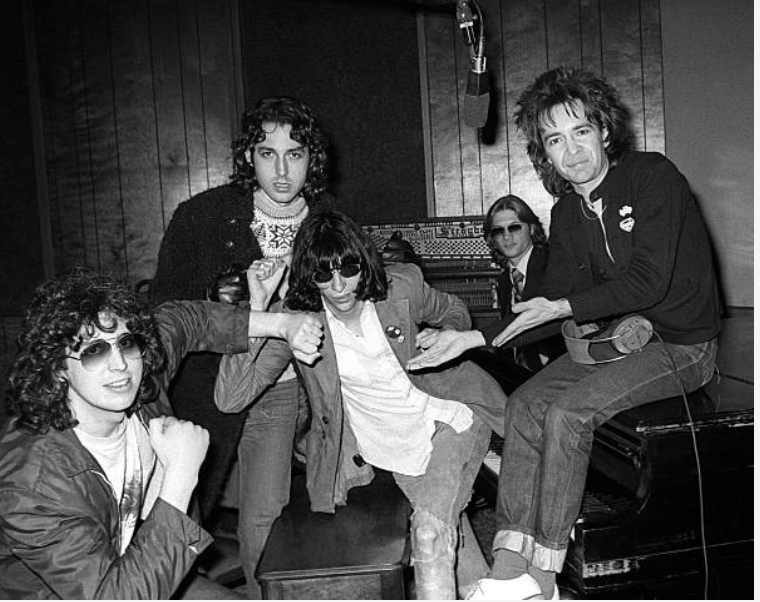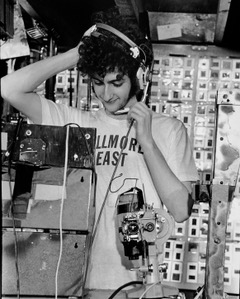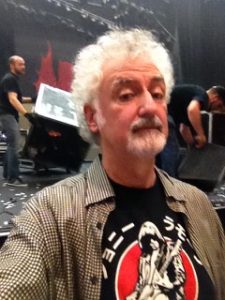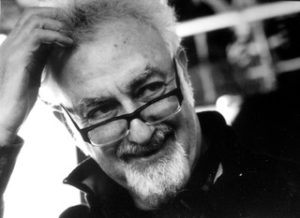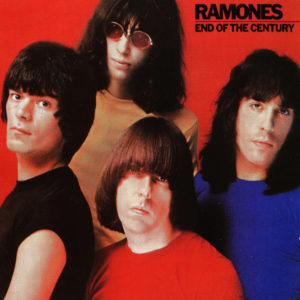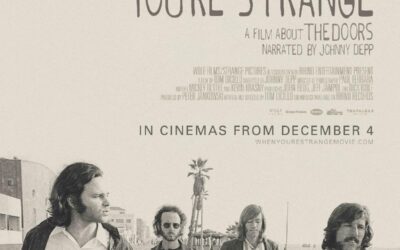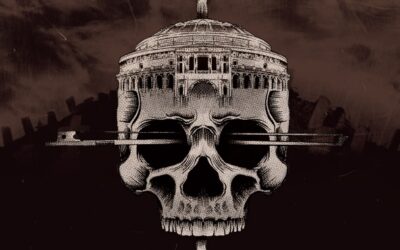…on Jimi Hendrix, Martin Scorsese, Bill Graham, Roger Corman, and the 40th anniversary DVD edition of his Ramones Rock ‘N’ Roll High School
By Harvey Kubernik © 2020
Allan Arkush was born in Jersey City, New Jersey in 1948 and graduated from Fort Lee High School which inspired his feature film directorial debut Rock ‘N’ Roll High School.
During 1967-1970 Arkush attended New York University Film School. Martin Scorsese was his teacher and faculty adviser. Arkush’s senior film, Septuagenarian Substitute Ball, starring John Ford Noonan, won third
prize at the National Student Film Festival In 1970.
In his years at NYU, Arkush worked at Bill Graham’s Fillmore East music venue as an usher and stage crew member. In 1970 he joined what was The Joshua Light Show-then renamed Joe’s Lights, collaborating with numerous visiting acts including Fleetwood Mac, the Who, Grateful Dead, Santana, Allman Brothers, and Miles Davis.
In 1973, Allan was driving a taxi in New York City when he received a destiny telephone call about coming to Hollywood.
Arkush relocated to Los Angeles in 1973 and got his start in the movie business in the trailer department for Roger Corman’s New World Pictures where he cut trailers with Joe Dante.
The duo created telegenic campaigns and commercial spots for over 100 films including Death Race 2000, Eat My Dust, Crazy Mama, and TNT Jackson. In 1977 Arkush was a second unit director for Ron Howard on Grand Theft Auto and in 1978 appeared as an actor in Roger Corman’s Hollywood’s Wild Angel.
Allan Arkush Filmography:
- Hollywood Boulevard (co-directed with Joe Dante) (1976)
- Deathsport (1978)
- Rock ‘n’ Roll High School (1979)
- Heartbeeps (1981)
- Get Crazy (1983)
- Caddyshack II (1988)
- Shake, Rattle and Rock! (1994)
- Elvis Meets Nixon (1997)
- The Temptations (1998)
- Prince Charming (2001)
Arkush has produced 200 episodic television shows, directing 250, including Fame, St. Elsewhere, Ally McBeal, and Nashville. He directed a fourth of the Moonlighting episodes, receiving an Emmy nomination for I Am Curious Maddie.
He’s helmed videos for Elvis Costello, Christine McVie and Bette Midler/Mick Jagger earning 5 MTV nominations.
Arkush is a member of the DGA Mentor Program, and currently teaching the Narrative Workshop at the American Film Institute in Los Angeles. Allan continues to contribute commentary to the web series Trailers From Hell.
I first met Allan on the set of Get Crazy in the very early eighties. The location was the Wiltern Theater, built in 1931 at the intersection of Wilshire Blvd. and Western Ave. in Los Angeles. The movie was informed by the experiences of Arkush and screenwriter Danny Opatoshu when they worked at Bill Graham’s Fillmore East venue in New York.
It starred Malcolm McDowell, Daniel Stern, Lou Reed, Howard Kaylan, John Densmore, Paul Bartel, Mary Woronov, Dick Miller, Fabian Forte, and poet/actor Ivan E. Roth portraying Electric Larry, based on a character Arkush encountered backstage at the Fillmore East when Jimi Hendrix cut the Band of Gypsys live album.
The next time Allan and I talked was in 1982 in the hallway at Roger Corman’s New World Pictures on San Vincente Blvd. in Brentwood.
American International Films visionary and independent movie pioneer Corman had made The Student Nurses, Caged Heat, White Line Fever, and Crazy Mama, while helping launch the filmmaking careers of Jonathan Kaplan, Jonathan Demme, Paul Bartel, Ron Howard and Joe Dante. My friend Harry E. Northup had starred in Fighting Mad with Peter Fonda that Demme directed. Bruce Langhorne did the musical score.
Filmic visionary Corman acquired foreign movies for domestic exhibition from acclaimed directors Ingmar Bergman, Cries and Whispers, Federico Fellini’s Armacord, as well as Uli Edel’s Christiane F.
At the time I had a girlfriend who worked for Corman. She re-introduced me to Roger, Samuel Z. Arkoff and Paul Bartel at an AIP /New World Pictures tribute event at Melnitz Hall on the UCLA campus.
One afternoon, inside Corman’s office, I mentioned the Gilmore Drive-In on 3rd street to Roger. He touted his previous AIP movies and New World’s successful drive-in only scheduled films where he booked them with distributors as “ozone pictures.”
I later ran into Alan Arkush in the late eighties on the Fox Studios back lot when he was directing an episode of Moonlighting with Eva Marie Saint as a guest star.
During 2019 director/producer Andrew Solt of SOFA Entertainment invited me to a special screening of Heroes of Rock and Roll at the Fine Arts Theatre in Beverly Hills, a 1979 two-hour ABC-TV special he produced, directed and wrote with Malcolm Leo hosted by Jeff Bridges. Jack Haley Jr. was the executive producer.
I attended their genre-changing premiere at the Plitt Century Plaza Theater. The rock documentary now had a new model. Solt and Leo had officially licensed master recordings of the last 25 years edited with video tape, newsreel footage, rare concert films, and trailers all sanctioned by rights holders and music publishing administrators.
When Heroes had its lone broadcast on ABC in 1979 I didn’t have a Sony Betamax machine to tape it! It’s never been available on VHS or DVD format. I was eagerly looking forward to watching it again on Wilshire Blvd.
I had a quick chat with Allan Arkush in the Fine Arts lobby about Jimi Hendrix. We exchanged digits. Allan had read me for years in the now defunct UK music weekly Melody Maker and owned one of my books. I arranged an interview to discuss Jimi and his Rock ‘N’ Roll High School 40th Anniversary Edition.
Arkush’s movie debuted in August 1979, produced by Michael Finnell, screenplay by Richard Whitley, Russ Dvonch and Joseph McBride, from a story by Arkush and Joe Dante.
Lensed at a B-movie pace in 1979, Arkush shot Rock ‘N’ Roll High School in Los Angeles at Mount Carmel High School where Rock Around the Clock was filmed in 1956.
Special features on this anniversary product include a new 4K scan from the original camera negative, and a new feature-length documentary titled Class Of ’79: 40 Years Of Rock ‘N’ Roll High School – featuring Interviews with director/story writer Allan Arkush, co-director/story writer Joe Dante, actress P.J. Soles, screenwriter Richard Whitley, screenwriter Russ Dvonch, cinematographer Dean Cundey, editor Larry Bock, and more.
There’s also an interview with Roger Corman conducted by Leonard Maltin, original radio ads and TV spot, even audio outtakes from the Roxy Theater filming along with the theatrical trailer.
With musical performances from the Ramones, the outrageous candor of teenage angst and nostalgic reverie of a counterculture rock movement, Rock ’N’ Roll High School has captured the hearts of many generations.
Executive produced by Corman and directed by Arkush boasts performances by the Ramones and stars P.J. Soles (Halloween) in the lead role of Riff Randell, Vince Van Patten (Hell Night), Clint Howard (Grand Theft Auto), Dey Young (Spaceballs), Mary Woronov (Death Race 2000), Dick Miller (Piranha) and Paul Bartel (Hollywood Boulevard).
Based on Arkush’s own high school fantasy, the 1979 cult film takes place at Vince Lombardi High School — the wildest, most rockin’ high school around! That is, until a thug of a principal, Miss Togar, comes along and tries to make the school a totalitarian state. With the help of the Ramones, the students of Vince Lombardi battle Miss Togar’s iron-fisted rule and take their battle to a rockin’ conclusion!
Rock ’N’ Roll High School quickly developed a devoted following after its release in 1979 and became a mainstay of the midnight movie cult circuit. As with films like The Rocky Horror Picture Show, audience members began to dress up like the cast and the Ramones for screenings.
In the Shout! Factory press materials provided, Arkush, the self-described “unabashed rock ‘n’ roll fanatic,” explained why he chose the Ramones to star as the film’s musical heroes, as he felt they epitomized pure rock ‘n’ roll.
“We staged a live, marathon show at the Roxy Theatre that consisted of 22 hours of nonstop Ramones,” and the tireless quartet also wrote two songs for the film: ‘I Want You Around’ and ‘Rock ’N’ Roll School.’ The Ramones were fans of Corman as well. Johnny Ramone said in an interview at the time, ‘When we found out Roger Corman was behind the picture, we said, sure, we’ll do it because we knew he had a reputation and we knew he made good movies.’”
“If you think things are polarized now, you should’ve seen (and heard) Toronto circa 1979,” recalls old slash new waver Gary Gabba Gold. “The Summer of Hate still fresh in most hip teens’ memories, it seems you just could no longer like, for example, both the Ramones and The Who. At the same time. And seeing as both Rock ‘N’ Roll High School and The Kids Are Alright shared a common distributor up in the Great Wide Northlands, both of those rockin’ reelers shared a single, and singular Gala Premiere Event within a hitherto genteel movie palace just off Toronto’s fabled Yonge Street Strip.
“That momentous night was my first of many many viewings since of Johnny, Joey, Dee Dee and Marky’s brat-beating silver screen debut and, in the grand tradition of Carnival Rock, The World’s Greatest Sinner and even Wild Guitar, that first of what should have been a long loud string of Ramone-starring vehicles looks, and it goes without saying sounds every single frame as cinema-shaking and status-quo-quaking now as it did back in those distant days of, well, comparatively big-budget Who documentaries. Why, even poor P. J. Soles got her guy in the end, regardless of how many takes it took Dee Dee to get his lone line — ‘Hey, pizza!’ — safely onto celluloid. And where else, honestly, can you see gigantic lab rats frugging to ‘Teenage Lobotomy’ I ask you?
“So I still can’t quite fathom why, as the end credits, not to mention Vince Lombardi High, crashed and burned to black that night in Toronto, practically every faux-leather-jacketed p-rocker in attendance defiantly abandoned their seats to mock ‘n’ mosh all the Who fans streaming down the aisles to immediately replace them as Kids got queued up. Because K. Moon for one certainly would have enjoyed, not to mention thoroughly identified with his kindred spirits from Queens …had he managed to live a year or so longer that is. And need I even mention none other than Pete Townshend Himself eventually sang along with no less than ‘Substitute’ on that penultimate Ramones long-player?!
“Oh! And while we’re on the subject: Would anyone out there happen to know whatever became of Marla Rosenfield? Just wondering…”
Harvey Kubernik and Allan Arkush Interview
Q: You have always been a music guy.
A: I was a record collector and had been a deejay in college. I saw Bob Dylan go electric at Forrest Hills in New York with [Michael] Bloomfield on guitar, introduced by Murray the K. When Dylan sang “Ballad of a Thin Man,” it was like an arrow pierced my heart. I caught the Blues Project a couple of times and was a huge fan, and the Mothers of Invention at the Garrick Theater. I saw the Yardbirds, Country Joe & the Fish and Janis [Joplin] when I was a film student in New York.
Q: Let’s talk about Jimi Hendrix.
A: I got tickets for Jimi Hendrix for his Friday night late show May 10, 1968. Opening act is Sly & the Family Stone. Jimi was great. And then something happened on stage that made it transcendent and one of the amazing rock and roll moments I had ever witnessed.
He was playing the intro to ‘Foxy Lady’ in front of these giant Marshall amps with the big tops on them. And it just clicked off and overloaded. The roadies go crazy and then put two of ‘em up there and now Jimi has twice as much power. And when he throws the switch to turn on his Fender this buzz happened and he starts laughing…He’s mesmerizing and starts to walk toward the amp with his back to the audience and this feedback thing starts building up and this electromagnetic thing happening and it’s vibrating and you feel it in your chest and he turns a knob, walks to an amp, catches this sound and twists it into the opening note of ‘Foxy Lady.’ And he backs up and slings it at us, like he’s playing lacrosse. He takes that note of the guitar and hurls it towards the audience. And the first note of ‘Foxy Lady’ you could hear it out on 2nd Avenue.
You know when you are at the beach and you realize there is a giant breaker coming towards you and it just hits you so hard you have no chance to move that was what the opening chords of ‘Foxy Lady’ were like. It was a transcendent performance until end of set. The dexterity and the skill that he played with were so amazing, and his technical ability. Watching Jimi grab that note and moving it was like Fantasia in rock ‘n’ roll. He became the colors and sound of the music and the movement of the music.
Q: Martin Scorsese was your teacher and faculty adviser at NYU.
A: On the first day the head of the film school sat down and played us a couple of student films. The best one was It’s Only You Murray. The filmmaker was Martin Scorsese who eventually became my teacher at NYU. Marty had in 1968 an American film history class, based on the auteur theory. There were only about six film schools in the country and the one textbook was Andrew Sarris’ American Film.
The first movie Marty screened for us was Shock Corridor by director Sam Fuller. The next week was a real line in the sand when he showed us a movie with John Wayne, The Searchers. Then The Big Heat by Fritz Lang. And then imagine showing us Jerry Lewis’ The Nutty Professor. He told us about Kenneth Anger’s Scorpio Rising and Visconti’s The Dammed. Scorsese would also suggest movies to see in New York and on TV. He’d show us TV Guide in the class.
I responded to it along with my passion for film history. Then Marty was my production teacher. I was so lucky. Not just because it’s Marty, but to have the same person teaching me film history and production.
One day he said “I’ve seen a movie last night that will change everything forever. We will no longer look at action scenes and violence in movies the same way again. It opens this week and it’s called The Wild Bunch.”
I went opening night. Half the class is in line with me. End of the movie we were so shaken we all went out to a bar and drank whisky and talked about what we had seen.
Marty knew I worked at the Fillmore East and I would always tell him who was coming. And he would ask for tickets and I thought he was amazing and just having him as my teacher. I had not seen Who’s that Knocking? I would get him the same seats, fourth row, slightly on the left for him, Jay Cocks and two of their dates for different groups. Marty wanted to see Spooky Tooth. He wanted tickets for the Who, Grateful Dead but the group that he wanted tickets for than anything else, and he asked me almost every day about it was The Band. How was that for a fucking connection?
On the night of the shows I’d come out and say hello. I certainly said hello on the night The Band played because there was no light show and I was on the stage crew. But I knew his connection to all this.
In fact on Thanksgiving of 1969, after Woodstock, he came down to the theater with [director] Michael Wadleigh and a whole bunch of other people and they did picture and sound system and ran us a couple of rough cut scenes which was being edited to get the reaction of the real rock and roll people. [Scorsese edited Sha Na Na, Sly & the Family Stone and Santana].
So we had Thanksgiving dinner, saw those clips and I remember seeing Ritchie Havens, Canned Heat and some other people. To end the evening we all went up to Madison Square Garden to see the Rolling Stones. Jimi Hendrix and Janis Joplin are sitting behind the amps. On that show Terry Reid opened, B.B. King and the most awesome performance ever by Ike & Tina Turner and the Stones set that had ‘Gimme Shelter.’ How’s that for a good day?
Q: A bio-regional relationship existed between NYU and the Fillmore East.
A: Whatever coincidence, six inches from the Fillmore East was the source of the genius that made the Fillmore East.
And that was the NYU Theater School, right next door. If you were at the NYU Theater School you were just like Scorsese and the people then. You were the theater version and these were the tech guys and they had no place to go after they graduated because Broadway was dominated by older men and it was all about seniority. So you couldn’t get a job. Or if you got a job you were the lowest of the low.
Q: Bill Graham understood the role of sound in all of his stage productions. In 1976 he told me “In the long run it’s the public. I really sincerely feel this is the reason the relationship lasted over the years. We always had the same goal. We want to turn people on and we want them to have a good time.”
A: At NYU they took sound engineer Bill Hanley and he installed a sound system at the Fillmore East. With the help of Hanley and the technical knowledge they had and started building it week by week and month by month. And, as time went on they started understanding the building and what was possible. And it was not unusual to come in on a Sunday night and help them set up the most advanced sound tracking equipment you can get.
Bill Graham did not just care about the sound. We took pride in having the best sound and lights in the world. And it’s a complete coincidence of geography that that happened. Bill wanted good sound and hired Hanley Sounds because there was nobody doing sound for rock concerts.
All of a sudden this theater starts coming alive right next door and they go next door to see what is going on and they get hired. All those people are the newest and the finest of the people who are starting to make the conversion. So they took Hanley Sound System with the help of Hanley and the technical knowledge they had and started building it week by week and month by month. And, as time went on they started understanding the building and what was possible. And it was not unusual to come in on a Sunday night and help them set up the most advanced sound tracking equipment you can get. Where they were doing pink noise generators and white noise generators and putting up padding in different places and tuning the building.
It was around the time Jimi Hendrix was forming Band of Gypsys. And in 1969 I am on the stage crew at Fillmore East, as an usher, in the stage crew. Being on the stage crew was life changing.
Q: Later Roger Corman enters your life.
A: I cut trailers for years with Joe Dante for Roger. We brought the spirit of rock ‘n’ roll as I knew it and into every aspect of the productions.
Roger and Bill Graham. Imagine going to film school and basically telling your parents you were not going to be a lawyer. Not happy. Now I’m in film school working at the Fillmore. All of a sudden I am surrounded by
people who were older than me and were responsible people.
So it was possible to be passionate about you are doing and not be like my parents. And that was the example of what I got from Bill. He was driven. He had the responsibility for the business but he was so passionate about rock ‘n’ roll. You could talk to Bill and get to know him. He leant me the Fillmore East to do my student film. Can you imagine?
Bill Graham and Roger forged their own destinies. The thing where they are alike is that they are so smart enough to trust the people that they hire. And they understand the territory to let the person in, beyond an employee. They had the ability to read who you are. They both bestowed on me the best of the information of their world because I asked. And, Roger made me understand how to direct.
And now when I teach at AFI it’s what I learned from Marty, Bill and Roger synthesized into my own course. So if you are in my course now you get the best of what I learned from those three men.
Q: How did your movie with the Ramones start? I handclapped with Rodney Bingenheimer on the Rock ‘N’ Roll High School recording session Phil Spector produced for the Ramones’ LP End of the Century.
A: The original idea of the film came in pieces when I was in high school. I was the kind of kid who did not apply themselves. And I would stare out the window in class, I was bored, and I came up with this fantasy that a rock and roll band was going to come to my high school and play. And all the students would run out of class and watch this concert. And the band I chose for this just couldn’t be any band in my fantasy. They had to have a certain fantasy. So here’s the band I had in my mind: The Yardbirds, the Rolling Stones or the Kinks, because they all had that nasty sounding single sense.
This was early in my record collecting. I had that fantasy and an ongoing fantasy of the kids taking over the school and doing stuff like riding motorcycles up and down the hallway. And up and down the stairs. In my head I had a race that took place, in French class.
That was the first part of the fantasy. Then I thought I’d write something about this fantasy. Then I heard this Todd Rundgren song ‘Heavy Metal Kids’ in the early seventies, it really got to me. So I started writing a treatment of kid rock bands in schools.
And then I saw lots of rock bands at the Fillmore. Every classic rock band four or five times and did the lights. I talked to Roger Corman who was willing to let me do Hollywood Blvd. There was a high school comedy Girls Gym with Michael Finnell who worked at New World and was with me every step of the way from the beginning. He found the high school.
Joe McBride wrote the early draft of Girls Gym. Joe presented me with the idea of the students doing a walk out and going on strike, because that had happened with someone in his family. That was central. And then he suggested that the students blow up the high school at the end. I said no. I could not imagine that. And after about two weeks I turned to Joe and we went to Roger. “We want to blow up the high school at the end.” He loved it. “That’s a great point. Maybe we can sell the movie.” Good. Because I wanted to get rid of the nude gymnastics that was scheduled for Girls Gym.
Roger didn’t hate rock and roll but didn’t know it. Not part of his daily life style. He didn’t know the difference of between disco music and rock music in terms of what it meant. But we were making Girls Gym and I think maybe one of the girls was in a band, did that for a while. We were at a certain point in the script.
Then Roger asked me to save this movie Deathsport while I was working on Girls Gym but it was not going well. He said “why don’t you save this movie? And I will make your high school musical.”
Grease and disco movies like Saturday Night Fever were big at the time. And I said “absolutely.” On the telephone he says “we’ll call Disco High.” “That sounds great!” And in my mind it was never going to be called Disco High.
Mike and I had a script but it wasn’t funny enough. Then two guys, film students from Illinois contact New World, Richard Whitley and Russ Dvonch, who want New World to watch their student film. Joe Dante and I see it. Deathsport is in production. And there are lots of people in the New World lobby playing mutants in the movie, wannabees and budding filmmakers. The assistant director is getting names. Russ and Richard are in the lobby. “Are you here to be mutants?” “No. we’re here to be writers.” They get hired.
We have a meeting on the Deathsport set and they’re pitching ideas at us. Mike and I make it a comedy. We ask them to write ten pages by Monday. “Re-write some parts.” We’re talking story with two mutants. OK. We get the pages by Monday. They invented characters and get hired to write jokes for Disco High. We confide to them it’s now really a rock ‘n’ roll movie, and the only time disco is mentioned is on the title page. So the script and the movie changes and Mike and I go to Roger and break it to him.
Q: The direction and the name of the movie evolved.
A: That’s when I started thinking seriously about a group in it. And at some point in this process, because of the genesis of “Heavy Metal Kids,” and the fact I liked Todd Rundgren, Mike and I went up to San Francisco to meet with Todd Rundgren This is late spring or early summer 1978.
It didn’t work out with Todd. And we also talked to Cheap Trick. Rodney the KROQ-FM deejay was playing Cheap Trick’s Live at Budokan album as an import LP. Rodney is a major source of the music heard during the making of this movie. It’s very hard to find rock music that has humor in it and really rocks. Those things don’t usually go together. The Who have it in places but there was no way I was gonna get the Who.
Van Halen was suggested, a wild rock and roll band. I got a meeting with the Ramones from a lawyer who worked at Warner Bros. Records, but was now working for Roger Corman, Paul Almond.
In the meeting I was explaining the difference between disco and hard rock, and demonstrating how the Who destroyed their instruments at the end of sets. You had to have that kind of feel. Roger listens. He has passion, is shrewd and turns to Paul Almond, who was from the music business, and said, “What do you think, Paul?” “He’s absolutely right.”
They like the new title. Paul then sets up a meeting with the head of A&R for Warner Bros. Records. We talked about Van Halen, I had heard them on Rodney’s KROQ-FM radio show, and the thought was “they might be too uncontrollable.”
We also saw the first videos of Devo. They were cool. It was already a complete thing. They had their costume and everything. Then we started talking about music in general and asked if I knew Sire records. And I had the Talking Heads. I knew every band he talked about. And he’s impressed. “What about the Ramones?”
I thought Rocket to Russia was one of the top ten albums ever made. At a certain age you find the music you love and end up with people who identify with this music and help define your own persona.
Seymour Stein at Sire Records was very active with us during the production sending us albums on Sire that he heard and felt were appropriate. We almost had the Clash’s “White Riot.” After we wrapped, Seymour took me into his office and played me the Pretenders’ “Stop Your Sobbing.”
Q: What about after the movie was released.
A: Let’s be really honest here, it was a movie that nobody saw, except midnight movies. It had no profile.
The movie first opened in Texas! Johnny Ramone called me and asked “Why did you open the movie in Texas and New Mexico? We’ve sold about 150 copies there.” The main distributor never liked the movie. He thought it was a commercial for the Ramones.
That movie was on a respirator until Siskel and Ebert reviewed in in Chicago. We were dead. It played in Chicago with two different movies Grease and Dawn of the Dead. The local distributor did well with Corman films. It played as a Midnight Movie. The audiences came out very satisfied. It did two weeks and started to travel to different territories screening at downtown theaters, drive-ins, grind house cinemas, and a few suburban theaters. The pattern developed: Atlanta, Boston and New York.
Then by sheer coincidence the Ramones are playing San Francisco and I schlep up there with my wife. I’m still working in the trailer department at New World. Sire Records and their publicity people really get going. The movie does OK but not quite enough to be a hit.
Then it gets booked in New York City at an art house and plays on a Friday night with The Rocky Horror Picture Show. Joey and I did some radio shows. The screening in New York City is packed and they went nuts! It was one of the highlights of my life. Seymour Stein and his Sire Records label toss a party for us at The Mudd Club. The movie made its rounds.
Q: It had a life for a while on Betamax and video store rentals.
A: It came out later on VHS and I was really thankful because all of a sudden it’s in all these stores. And people are taking a real interest in it and then it went away through various deals and it was nowhere for ten years. And people and fans were always asking me about it.
Roger’s licensing deal with Warner Bros. expired. Roger sells the rights to Lumivision for a laserdisc. It had some new items we prepared for the package. A letter to the fans, reviews. Mike and I did a commentary for the laserdisc.
Then Roger sold it to Buena Vista. They didn’t want past materials, and had self-imposed concerns about clearance rights on photos. They didn’t even clean up the picture or the sound. The poster isn’t on the box. There’s a picture of a guitar. I did a lot of work for nothing and was upset with Buena Vista. I wrote a letter to Buena Vista and Roger. And Corman ends his deal with Buena Vista. Then Joey dies and later Johnny dies. The Ramones become bigger.
Q: And we have a 40th anniversary Rock ‘N’ Roll High School product.
A: Earlier this decade Shout! Factory contacts me about a new DVD reissue. They bought the rights to the movie. We have a sit down meeting and I got real respect. They do the definitive edition. The new DVD has new video interviews, commentary and every single photo from the crew. Someone found the original negative that was in a vault.
My goal was to make the viewers of 1979 and now in 2019 to feel the way I did on that first night when I saw A Hard Day’s Night played.
There was a screening for it at Hollywood Forever, the cemetery in Hollywood. I noticed there were more women now in the audience than men. Everyone loves the Ramones. But it’s the combination of the Ramones and Riff Randell who sustain the movie. Women in their forties and fifties come up to me and happily confess how much this movie meant to them when they were in catholic school. They tell me stories of hiking up their dresses and singing Ramones’ songs to the nuns.
So many young women and older women talk to me about what Rock ‘N’ Roll High School meant to them. And I realized that the movie would not be around if it wasn’t for this magical chemical reaction between the female empowerment of Riff Randell and the Ramones music.
As far as this 40th anniversary DVD reissue, I can sum it up in one sentence: I was the kind of kid who used to read the back of the album. The more information I got the happier I was.
As a filmmaker this is a way for me to respond to people and the fans. And I’ve never talked to them. There is a group of people that this stuff is aimed at that I have a real debt too. And that goes back to Riff Randell.
Who was Riff Randell? And that’s the kind of key to this reissue. After all this time, concerts, life, at this point, thousands of people have come up to me, they figure when they are working with me they look up my IMDB, they know who I am.
It’s all about Riff Randell, who is composed of three young women who hung at the Fillmore East all the time, who I went to see the Stones at Madison Square Garden with: Gail, Diane and Janis. They were all pure rock fans, and so when I was making the movie that’s how I wanted to embody the character to do.
It was made for a very loyal audience who have a story to tell me when I meet them about how this movie changed their life. Or, how they could be in control of themselves like Riff, and didn’t take shit from anyone, and how the music accents this. And the choice of the Ramones fits so well into Riff’s personality and the girl group influence on Joey, the lasting power of Riff Randell and now the lasting power of the Ramones fans.”
Also look for an expanded reissue of the Ramones’ 1980 End of the Century album with additional “Rock ‘N’ Roll High School” recording sessions in 2020.
David Kessel of cavehollywood.com worked and recorded with the Ramones during the Ramones stay in L.A.
“My brother Dan and I met the Ramones very early on, in the 70s, when they came to Los Angeles,” remembers David. “We saw their very first L.A. gig, at The Roxy. We were really drawn to their street sense, bubble gum urgency. We got it. We understood what they were doing. We had holes in our jeans before we even saw their first album cover. It all made sense, right away. Dan and I, along with our pal, visionary deejay Rodney Bingenheimer really appreciated how innovative they were. Their simple yet sophisticated music really nailed a new rock ‘n’ roll.
“We all hung out with the Ramones when they played with the Runaways and The Quick. I was impressed with their discipline and diligence. They even had bananas and orange juice in the dressing room. That show at the Santa Monica Civic was a Rodney Bingenheimer Presents event, along with Kim Fowley, a very high point in punk rock coming to L.A. We had a good time after the show at the Sire Records party on the Santa Monica Pier.
“Soon after that event, Dan, Rodney and I were invited to attend the recording session of the Ramones backing up the Paley Brothers doing the Ritchie Valens classic ‘Come On Let’s Go.’ A fun evening at the Beach Boy’s Brother Studio in Santa Monica, California. Seymour Stein led the festivities, enjoying seeing his Sire label mates working together.
“It was really cool when my brother Dan and I, along with Rodney, brought the Ramones into Gold Star Recording Studio in Hollywood. Joey had asked me and Dan if we would record the band doing his pet song ‘Slug’ they had been working on. We ended up recording ‘Slug’ and a version of ‘Surfin’ Safari’ that Rodney had requested we do. We all had a blast.
“We called Phil Spector from Gold Star, and played him what we recorded over the phone, and he said ‘Pick up some pizza’s and bring the band over to the house,’ meaning his Beverly Hills mansion. It was a very funny evening going late into the morning. Since both Phil and the Ramones are New Yorkers, they kept talking about street corners. I, being from L.A. was never that passionate for a street corner except for Hollywood and Vine. The three of us (myself, Dan and Rodney) had previously brought Phil to see the Ramones at the Whisky A Go Go where they were on a bill with Blondie. So, this whole relationship was kind of a natural progression.”
This get together at Phil’s led to “End Of The Century”. Dan and I had various rolls in the making of this Album. Playing guitar and some other instruments, along with assisting Phil as needed. We got a kick out of
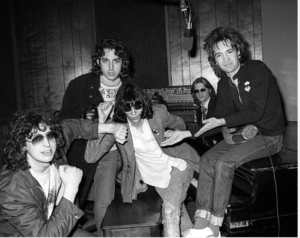
David Kessel, Dan Kessel, Joey Ramone, Blake Xolton, and Rodney Bingenheimer at the legendary Gold Star Studios in Hollywood during the recording of “SLUG” Photo by: Brad Elterman Copyright Kessel Bros International
seeing Ray Pohlman conducting his string arrangement on the Ramones “Baby I Love You” track. I really enjoyed being a part of this album and watching Phil work with the band. The last band he had worked with was the Beatles.
There is also a very cool version of “Rock N Roll High School” on “End Of The Century”. The Rock N Roll High School movie Is definitely The Ramones Hard Days Night”.
Long Live The Ramones!
This century Harvey Kubernik wrote the liner note booklets to the CD re-releases of the Ramones’ End of the Century, Carole King’s Tapestry, Allen Ginsberg’s Kaddish, Elvis Presley The ’68 Comeback Special, and teamed with Andrew Loog Oldham for the liner note essays for The Essential Carol King 2-CD compilation.
Harvey Kubernik is the author of 18 books, including 2009’s Canyon of Dreams: The Magic and the Music of Laurel Canyon published by Sterling/Barnes and Noble and in paperback edition in 2012.
During July 2020 Otherworld Cottage Industries will publish Harvey’s 500-page book Docs That Rock, Docs That Matter: Conversations with the Greatest Rock Documentarians of Our Time. Kubernik interviews with D.A. Pennebaker, Albert Maysles, Murray Lerner, Morgan Neville, Michael Lindsay-Hogg, Andrew Loog Oldham, Dick Clark, Allan Arkush, and David Leaf, among others.
During November 2018, Sterling/Barnes and Noble published Kubernik’s The Story of The Band From Big Pink to the Last Waltz. Kubernik is currently writing and assembling a 2021 book on Jimi Hendrix for the same publisher.
In 2020 Harvey Kubernik served as Consultant on a new 2-part documentary Laurel Canyon: A Place In Time. Alison Ellwood is the director who helmed the History of the Eagles.
Laurel Canyon: A Place In Time will have a world premiere on television network EPIX that will broadcast on Sunday, May 31st at 10 p.m., and conclude the following Sunday, June 7th at 10 p.m.
Kubernik’s literary music anthology Inside Cave Hollywood: The Harvey Kubernik Music InnerViews and InterViews Collection Vol. 1, was published in December 2017, by Cave Hollywood.
Kubernik’s The Doors Summer’s Gone was published by Otherworld Cottage Industries in February 2018. It was nominated for the 2019 Association for Recorded Sound Collections Awards for Excellence in Historical Recorded Sound Research.
In 2006 Kubernik spoke at the special hearings initiated by The Library of Congress that were held in Hollywood, California, discussing archiving practices and audiotape preservation.
Kubernik’s 1995 interview, Berry Gordy: A Conversation With Mr. Motown appears in The Pop, Rock & Soul Reader edited by David Brackett published in 2019 by Oxford University Press. Brackett is a Professor of Musicology in the Schulich School of Music at McGill University in Canada. Harvey joined a distinguished lineup which includes LeRoi Jones, Johnny Otis, Ellen Willis, Nat Hentoff, Jerry Wexler, Jim Delehant, Ralph J. Gleason, Greil Marcus, and Cameron Crowe.

